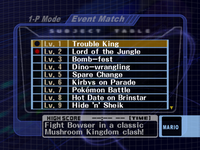Event match: Difference between revisions
No edit summary |
m (→In Super Smash Bros. Melee: seems unnecessary) |
||
| Line 6: | Line 6: | ||
==In ''Super Smash Bros. Melee''== | ==In ''Super Smash Bros. Melee''== | ||
[[File:EventMatchMelee.png|thumb|The ''Melee'' event match menu, with the first nine event matches visible; the red dots indicate events that have been cleared.]] | [[File:EventMatchMelee.png|thumb|The ''Melee'' event match menu, with the first nine event matches visible; the red dots indicate events that have been cleared.]] | ||
Event matches were introduced in ''[[Super Smash Bros. Melee]]'', as part of the game's re-tooled single player mode. Only 10 are initially given to the player, with the rest being added as the player fulfils a number of other objectives in the game. There are a total of | Event matches were introduced in ''[[Super Smash Bros. Melee]]'', as part of the game's re-tooled single player mode. Only 10 are initially given to the player, with the rest being added as the player fulfils a number of other objectives in the game. There are a total of 51 event matches in ''Melee''. | ||
A majority of event matches allow the player to select their character, though a number of them do require the player to use a specific character. Of note is that, with the exception of {{SSBM|Pikachu}}, all of ''Smash 64's'' "[[Original 12]]" characters have their own dedicated event match. | A majority of event matches allow the player to select their character, though a number of them do require the player to use a specific character. Of note is that, with the exception of {{SSBM|Pikachu}}, all of ''Smash 64's'' "[[Original 12]]" characters have their own dedicated event match. | ||
Revision as of 22:06, April 19, 2018
- "Event" redirects here. For the events that occur randomly in Smash Run, see Smash Run.
Event match (イベント戦, Event Battle) is a single-player mode found in all Super Smash Bros. games starting with Melee. Event matches are special challenges that place the player into specific scenarios with special conditions and a certain objective that must be met. The game records the completion and "score" of each event match.
In Super Smash Bros. Melee
Event matches were introduced in Super Smash Bros. Melee, as part of the game's re-tooled single player mode. Only 10 are initially given to the player, with the rest being added as the player fulfils a number of other objectives in the game. There are a total of 51 event matches in Melee.
A majority of event matches allow the player to select their character, though a number of them do require the player to use a specific character. Of note is that, with the exception of Pikachu, all of Smash 64's "Original 12" characters have their own dedicated event match.
Unusual to Melee's event matches compared to other single player modes is that some event matches force characters to be in an alternate costume or fight against opponents in an alternate costume, such as in the Trophy Tussle matches.
Unlockable event matches
| Criteria | Unlocked content |
|---|---|
| Complete at least 6 of events 1-10 | Event Matches 11-15 |
| Complete at least 10 of events 1-15 | Event Matches 16-20 |
| Complete at least 16 of events 1-20 | Event Matches 21-25 |
| Complete at least 22 of events 1-25 | Event Matches 26-29 |
| Complete at least 27 of events 1-29 | Event 30: All-Star Match 3 |
| Unlock Jigglypuff, Luigi, Dr. Mario, Young Link, and Falco and complete at least 27 of the first 30 event matches | Event Matches 31-39 |
| Unlock all unlockable characters; and then complete at least 27 events | Event Matches 40-50 |
| Must complete all other event matches (Event Matches 1-50) | Event 51: The Showdown |
In Super Smash Bros. Brawl
A completely new set of 41 solo event matches was included in Super Smash Bros. Brawl and a separate set of 21 co-op event matches also included. Altogether there are sixty two event matches; 41 solo events and 21 co-op events. Brawl also introduced three difficulty levels for each event match (both solo events and co-op events); Easy, Normal, and Hard. Like in Melee, the player starts with 10 event matches, as well as 8 co-op event matches.
Unlike in Melee (where most of the events allow the player to choose any character), almost all of Brawl's event matches have an assigned character. Only the All-Star Matches and the final two event matches have set characters. This appears to be done so that players are forced to use nearly every character at least once. However, only Luigi and Jigglypuff lack an assigned event match. But even then, the two are required in two of the 21 co-op events; Co-Op Event 11: The Great Remodeling Battle (which has Luigi) and Co-Op Event 16: Jigglypuff's Great Comeback (which has Jigglypuff).
Unlockable event matches
| Criteria | Unlocked content |
|---|---|
| Complete at least seven of events 1-10 | Event Matches 11-20 |
| Complete at least eighteen of events 1-20; unlock Captain Falcon, Lucario, Luigi, Ness, Marth, and R.O.B. | Event Matches 21-29 |
| Complete at least 20 of events 1-29; unlock all characters | Events 30-40 |
| Complete all events 1-40 | Event 41: The FINAL Final Battle |
| Unlock Lucario, Marth, Ness, R.O.B., Captain Falcon, and Luigi | Co-Op Events 9-13 |
| Unlock all characters and complete at least ten of Co-Op events 1-13 | Co-Op Events 14-20 |
| Complete all co-op events 1-20 | Co-Op Event 21: The True All-Star Battle |
In Super Smash Bros. for Wii U

Event matches and co-op event matches return in Super Smash Bros. for Wii U and function similarly to those in Brawl, but are now arranged on a map instead of a linear list. Completing an event will unlock paths to more events on the map. Additionally, each event will yield a reward if completed under specified conditions, such as playing on a certain difficulty and/or achieving a certain score. Some events also have "hidden routes" that become available if certain requirements are met, such as a character being unlocked. In addition, scores earned will overwrite any inferior scores of lower difficulties; for example, completing an event on Normal difficulty in 30 seconds will also set the Easy difficulty's score to 30 seconds if it was slower or blank. Most events allow the use of customizations, but equipment that has players starting a match with an item will have their extra effect negated; for an example, Beam Sword equipment will not allow the player to start matches with the Beam Sword in any event match. Players can now use different alternate costumes for most character-specific events by picking customized characters who wear them.
All event matches must be unlocked by completing other events, with the only exceptions being the starter events: "The Original Heavyweights", located in the center of the solo events screen, and "A Lurking Menace", located in the top-left corner of the group events screen. Hidden routes have an additional requirement: players must unlock a specific character, or in the case of The Ultimate Battle, all of the characters, to reveal a hidden route.
As for the maps below, each color represents rewards for each event completed. Yellow means gold, Light green means a Crazy Orders pass and Dark green means a trophy. Any path showing a character's icon means that particular character needs to be unlocked before that event can be unlocked.
Solo events
Group events
See also
Trivia
- In the Wii U version, all randomized stages will be the same layout until quitting the Event screen. For example, Gamer will always have the same objects while Port Town Aero Dive will stop at the same places each time.
- Brawl is the only game in the series in which none of the event matches involve fighting bosses; aside from minor bosses such as Giant Bowser and Giant DK.
External links
| Super Smash Bros. Melee menu items | |
|---|---|
| Vs. Mode | Melee (Time · Stock · Coin Battle · Bonus · Team Battle) · Custom Rules · Special Melee · Tournament Mode · Names |
| 1-P Mode | Regular Match (Classic Mode · All-Star Mode · Adventure Mode) · Event Match · Stadium (Target Test · Home-Run Contest · Multi-Man Melee) · Training |
| Trophies | Gallery · Collection · Lottery |
| Options | Rumble · Sound · Screen Display · Language · Erase Data |
| Data | Snapshots · Melee Records · Sound Test · Archives (NTSC only) · How to Play (PAL only) |
| Unused | Debug menu · Debug sound test menu |
| Super Smash Bros. Brawl menu items | |
|---|---|
| Group | Brawl (Time · Stock · Coin Battle · Team Battle) · Rules · Special Brawl · Rotation · Tourney · Names |
| Solo | Classic · All-Star · Adventure Mode: The Subspace Emissary · Events · Stadium (Target Smash!! · Home-Run Contest · Multi-Man Brawl · Boss Battles) · Training |
| Wi-Fi | Spectator Mode · With Anyone · With Friends |
| Vault | Trophies & Stickers (Trophy Gallery · Trophy Hoard · Coin Launcher · Sticker Album · Sticker Center) · Stage Builder · Album · Challenges · Replays · Masterpieces · Chronicle |
| Options | Screen · Deflicker · Rumble · Controls · Sound · My Music · Erase Data |
| Data | Movies · Records (Group Records · Brawl Records · Notices) · Sound Test |
| Super Smash Bros. for Wii U menu items | |
|---|---|
| Smash | Smash (Time · Stock · Coin Battle · Team Battle) · 8-Player Smash · Special Smash · Rules · Controls |
| Games & More | Classic · All-Star · Stadium (Target Blast · Home-Run Contest · Multi-Man Smash) · Training · Events · Special Orders (Master Orders · Crazy Orders) · Custom · Stage Builder · amiibo · Vault (Trophies · Trophy Rush · Album · Replays · Movies · Sounds · Records · Tips · Masterpieces) · Options (Controls · Sound · My Music · Internet Options) |
| Online | Spectator Mode · With Anyone (For Fun · For Glory) · With Friends · Online Events (Tourney · Conquest) · Share |
| Other | Challenge · Smash Tour · 3DS |
